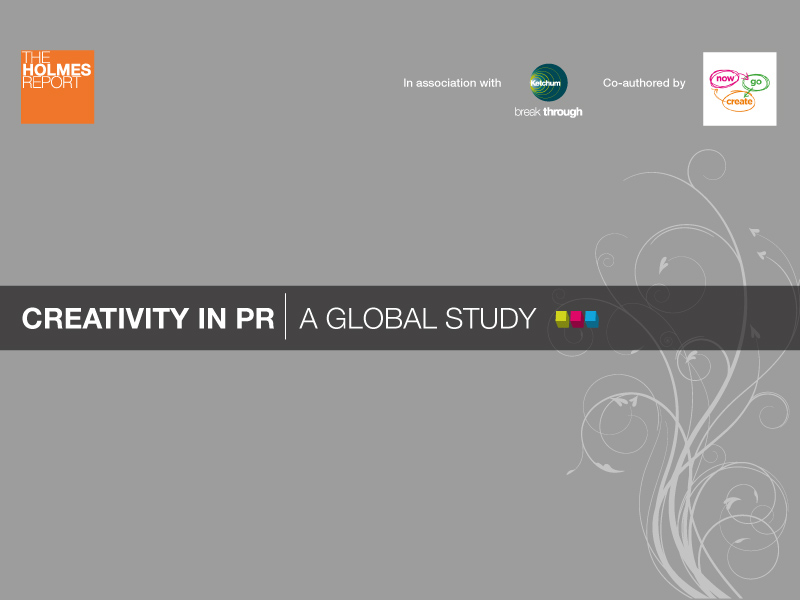Arun Sudhaman 13 Nov 2012 // 12:00AM GMT

NEW YORK--A landmark global study has found that big ideas and creative quality are key concerns for a PR industry that recognises the fundamental importance of creativity.
The Creativity in PR report is co-authored by the Holmes Report and NowGoCreate, in partnership with Ketchum, based on a survey of 650 PR people from more than 35 countries across the world.
Polling took place earlier this year, in a bid to explore whether the PR industry is creative enough to successfully sway marketing budgets and develop game-changing ideas on a consistent basis.
Respondents came from agency and in-house, across a range of industries and sectors, covering consumer, corporate, healthcare, technology, digital and public affairs. They answered a variety of questions during the two months the survey ran during the summer of 2012, focusing on attitudes towards creativity; tools and skills; opportunities and challenges; and suggestions and advice.
The study forms part of the Holmes Report's new Creativity channel, which aims to celebrate, explore and analyse creativity in the public relations industry.
The Holmes Report will explore the study’s key findings throughout this week, which include:
A lack of big ideas
61 percent of respondents agree that criticism of the industry for lacking big ideas is fair. Respondents were asked to expand on their replies, and many did so passionately, blaming clients, industry culture, competition from other disciplines and budgetary constraints.
"I do feel we are not taking ownership of the fact that we have always been an 'ideas' industry -- and are absolutely capable of breakthrough creative thinking," said one executive at a US PR firm. "Too many people in the field seem to be silo-ed in terms of what they feel they are allowed to do -- versus advertising agencies that seem to approach their business as if they can take ownership of anything, and any discipline, they want.”
Of even more concern, perhaps, a slightly higher proportion of in-house executives (66 percent) accepted the premise. Geographically, North America demonstrated the most resistance to the charge, with 44 percent saying that the statement regarding big ideas is unfair. Latin Americans were least impressed: a full three-quarters agreed with the observation.
An ambivalent take on creative quality
- Over 50 percent describe the quality of creativity within the PR industry as ‘ordinary’ or worse
- Just six percent labeled it ‘inspirational’
- 40 percent said it was ‘good’
- One in 10 described creativity as ‘unsatisfactory’
- Six percent said it was ‘poor’ or ‘non-existent’
Numerous responses pointed to an overall inconsistency regarding the quality of creativity in the PR industry.
"So difficult to say," responded a UK in-house executive. "I think there are pockets of hugely creative people but then a huge volume of non-creatives."
Geographically, those based in North America are most bullish about the industry’s creative quality. 51 percent of respondents from North America opt for ‘inspirational’ or ‘good’, and just 11 percent think it is ‘unsatisfactory’ or worse. Asia-Pacific, meanwhile, emerges as the least impressive region - 37 percent see creativity as ‘good’ or ‘inspirational’, and 20 percent think it is ‘unsatisfactory’ or worse.
Yet, the industry clearly acknowledges creativity as a fundamental skill (95 percent) and most respondents consider themselves creative (89 percent).
“Clients want more of it and the industry acknowledges creativity as a fundamental skill with agencies clamouring for awards,” said study co-author and NowGoCreate founder Claire Bridges. “Big ideas come from the sweet spot where bravery, time, imagination and talent meet.”
However, Bridges noted that it was perhaps “unrealistic” to expect PR channels to be “delivering big ideas day in, day out, because the industry has so many facets.”
“I have seen some incredibly nimble and creative thinking go into managing a crisis, but this kind of creativity is often behind the scenes and more nuanced than a smack-me-between-the-eyes award-winning campaign,” she added. “A creatively generated, positive conversation is so much harder to evaluate than the latest Christmas ad that the agency has spent all year working on and buys at peak time.”
Other key findings that will be explored this week include:
- The gap between aspirations and working practices
- The barriers to creativity that must be overcome
- Why creativity in PR remains difficult to define.
"Perhaps big is the wrong adjective to steer and judge creative ideas. The best creative ideas touch us emotionally, not because of their size or spectacle, but because they address a human truth,” adds Ketchum chief innovation officer Karen Strauss. “Creativity is not tactical or technical -- it's emotional. By pausing to develop insights before ideas, creative people in PR can and will deliver more creative work."


































.jpg)



















.tmb-135x100.jpg)










